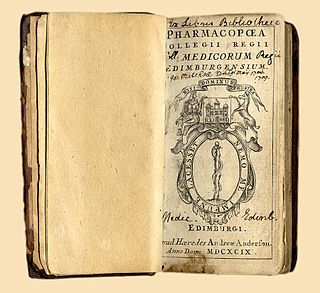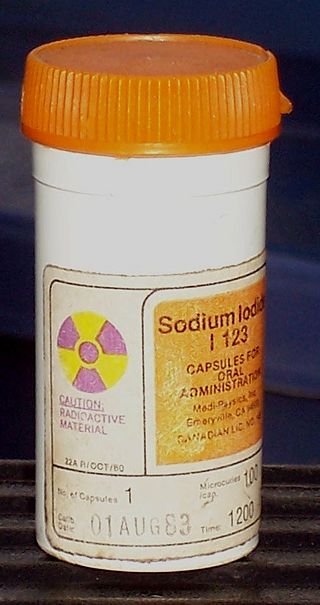Related Research Articles

Benzatropine (INN), known as benztropine in the United States and Japan, is a medication used to treat movement disorders like parkinsonism and dystonia, as well as extrapyramidal side effects of antipsychotics, including akathisia. It is not useful for tardive dyskinesia. It is taken by mouth or by injection into a vein or muscle. Benefits are seen within two hours and last for up to ten hours.

A pharmacopoeia, pharmacopeia, or pharmacopoea, in its modern technical sense, is a book containing directions for the identification of compound medicines, and published by the authority of a government or a medical or pharmaceutical society.
An international nonproprietary name (INN) is an official generic and nonproprietary name given to a pharmaceutical drug or an active ingredient. INNs are intended to make communication more precise by providing a unique standard name for each active ingredient, to avoid prescribing errors. The INN system has been coordinated by the World Health Organization (WHO) since 1953.
The United States Pharmacopeia (USP) is a pharmacopeia for the United States published annually by the over 200-year old United States Pharmacopeial Convention, a nonprofit organization that owns the trademark and also owns the copyright on the pharmacopeia itself.

Radiopharmacology is radiochemistry applied to medicine and thus the pharmacology of radiopharmaceuticals. Radiopharmaceuticals are used in the field of nuclear medicine as radioactive tracers in medical imaging and in therapy for many diseases. Many radiopharmaceuticals use technetium-99m (Tc-99m) which has many useful properties as a gamma-emitting tracer nuclide. In the book Technetium a total of 31 different radiopharmaceuticals based on Tc-99m are listed for imaging and functional studies of the brain, myocardium, thyroid, lungs, liver, gallbladder, kidneys, skeleton, blood and tumors.
A British Approved Name (BAN) is the official, non-proprietary, or generic name given to a pharmaceutical substance, as defined in the British Pharmacopoeia (BP). The BAN is also the official name used in some countries around the world, because starting in 1953, proposed new names were evaluated by a panel of experts from WHO in conjunction with the BP commission to ensure naming consistency worldwide (an effort leading to the International Nonproprietary Name system). There is also a British Approved Name (Modified) (BANM).
A United States Adopted Name (USAN) is a unique nonproprietary name assigned to a medication marketed in the United States. Each name is assigned by the USAN Council, which is co-sponsored by the American Medical Association (AMA), the United States Pharmacopeial Convention (USP), and the American Pharmacists Association (APhA).
The British Pharmacopoeia (BP) is the national pharmacopoeia of the United Kingdom. It is an annually published collection of quality standards for medicinal substances in the UK, which is used by individuals and organisations involved in pharmaceutical research, development, manufacture and testing.
The nomenclature of monoclonal antibodies is a naming scheme for assigning generic, or nonproprietary, names to monoclonal antibodies. An antibody is a protein that is produced in B cells and used by the immune system of humans and other vertebrate animals to identify a specific foreign object like a bacterium or a virus. Monoclonal antibodies are those that were produced in identical cells, often artificially, and so share the same target object. They have a wide range of applications including medical uses.
A formulary is a list of pharmaceutical drugs, often decided upon by a group of people, for various reasons such as insurance coverage or use at a medical facility. Traditionally, a formulary contained a collection of formulas for the compounding and testing of medication. Today, the main function of a prescription formulary is to specify particular medications that are approved to be prescribed at a particular hospital, in a particular health system, or under a particular health insurance policy. The development of prescription formularies is based on evaluations of efficacy, safety, and cost-effectiveness of drugs.
A Japanese Accepted Name (JAN) is the official non-proprietary or generic name given to a pharmaceutical substance by the government of Japan.
Sofituzumab vedotin is a monoclonal antibody designed for the treatment of ovarian cancer.
Pinatuzumab vedotin is a monoclonal antibody designed for the treatment of B-cell malignancies.
Seribantumab is a monoclonal antibody designed for the treatment of cancer. It binds to extracellular domain of HER3 blocking NRG1 binding and thereby preventing the activation of the receptor.
Brontictuzumab is a humanized monoclonal antibody designed for the treatment of cancer.
Denintuzumab mafodotin is a humanized monoclonal antibody-drug conjugate designed for the treatment of CD19-positive acute lymphoblastic leukemia and B-cell non-Hodgkin lymphoma. It consists of an anti-CD19 mAb linked to monomethyl auristatin F (MMAF), a cytotoxic agent. This drug was developed by Seattle Genetics.
Lumretuzumab is a humanized monoclonal antibody designed for the treatment of cancer.
Rosmantuzumab is a humanized monoclonal antibody designed for the treatment of cancer.
In chemistry, chemical purity is the measurement of the amount of impurities found in a sample. Several grades of purity are used by the scientific, pharmaceutical, and industrial communities. Some of the commonly used grades of purity include:
References
- 1 2 3 4 "How drugs are named". UCB. 2011-12-09. Archived from the original on 2013-05-31. Retrieved 2013-01-01.
- 1 2 3 4 5 6 7 8 9 10 11 12 13 14 15 16 17 "United States Adopted Names naming guidelines". American Medical Association. Archived from the original on 19 August 2023. Retrieved 22 January 2021.
- 1 2 Lowe, Derek (23 October 2006). "Experimental Compound Codes". Science. Archived from the original on 1 June 2023. Retrieved 20 November 2015.
- ↑ "The use of stems in the selection of International Nonproprietary Names (INN) for pharmaceutical substances" (PDF). The World Health Organization. Archived from the original (PDF) on 4 April 2023. Retrieved 28 November 2023.
- ↑ "Directive 2001/83/EC of the European Parliament and of the Council of 6 November 2001 on the Community code relating to medicinal products for human use". The European Parliament. Archived from the original on 25 July 2019. Retrieved 23 January 2021.
- ↑ Silverman, HM (2007-04-01). "Overview of Generic Drugs and Drug Naming". Merck & Co. Archived from the original on 2013-01-01. Retrieved 2013-01-01.
- 1 2 World Health Organization, INN and Biologicals, archived from the original on October 15, 2013, retrieved 2016-06-16.
- ↑ "Penicillin". Drugs.com. 2010-12-15. Archived from the original on 2023-08-22. Retrieved 2013-01-01.
- 1 2 Gylys BA, Wedding ME (2005). "-zumab". Taber's Cyclopedic Medical Dictionary/medical Terminology: A Systems Approach. Medicus Media. p. 2371. ISBN 0803613245.
- ↑ "Antibody Production (Immunogen Preparation)". www.piercenet.com. Archived from the original on 2013-10-17. Retrieved 2013-10-17.
- 1 2 Merriam-Webster, Merriam-Webster's Medical Dictionary, Merriam-Webster, archived from the original on 2020-10-10, retrieved 2015-01-27.
- 1 2 Oxford Dictionaries, Oxford Dictionaries Online, Oxford University Press, archived from the original on May 16, 2001.
- 1 2 Elsevier, Dorland's Illustrated Medical Dictionary, Elsevier, archived from the original on 2014-01-11, retrieved 2015-01-27.
- 1 2 3 4 "Information for Late-Breaking Abstract Authors". American Society of Hematology. 2014. Archived from the original on 24 November 2015. Retrieved 23 November 2015.